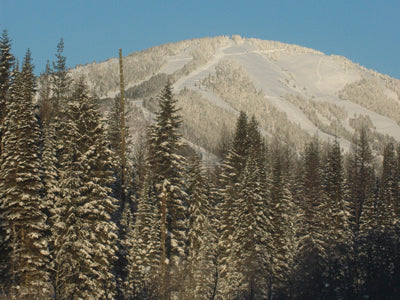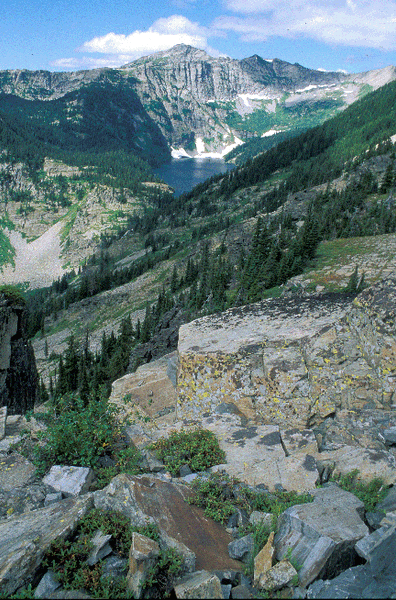Where to Retire: Libby, Mont.
As a Montana retirement town, Libby mixes smalltown values, vision for future

Kootenai River near Libby, Montana. Gordon Sullivan photo
By Gordon Sullivan
I can remember the very first time I laid eyes on the amazing town of Libby, Montana.
Evening was upon us and it was approaching the warm glow of sunset. I was a passenger in an exploration helicopter, bouncing its way like a dragonfly across the Cabinet Mountain Wilderness. Around the western toe of the big mountains, the helicopter banked sharply to the east just as a bright shaft of light reflected off the silver thread of the Kootenai River. The golden light set the densely timbered shoulders of the narrow Kootenai Valley ablaze. It appeared like a beacon through the foggy mist rising off the Kootenai Falls, where a stunning rainbow arched across one corner.
Minutes later, the mountain town of Libby appeared as if it had fallen out of nowhere. It was nestled like a gem beneath the snowy flanks of Treasure Mountain and the north face of the Cabinet Mountains. I craned my neck as we passed, and watched the small town slowly disappear in the distance, framed by the huge mountains and the subtle tint of autumn larch across the timbered ridges. We shot north along Highway 37, while the Kootenai River raced madly by us.
The entire experience took less than a few minutes, but it was destined to stay in my memory for a lifetime. Almost 20 years later, I returned to the Kootenai Valley driving a big U-Haul truck filled with everything I owned. I was ripe and ready for a change, and the town of Libby would more than meet my expectations.

Libby native Rick Jaqueth skis powder on Turner Mountain in Libby, Montana. David Reese photos

Turner Mountain ski area near Libby, Montana. David Reese photo
Libby’s past is similar to many other northwest mountain towns. It comes from a rich legacy forged by the hard work of loggers, mill workers and early-day miners. During the 30 years the town’s economy was lulled into a sense of security by the boom brought on by the construction of the Libby Dam and the development of new roads. At the same time, mines operated, a lumber mill turned out valuable wood products, and the timber industry was vibrant and healthy.During those days, native Jeff Gruber says, there were three jobs awaiting any man who wanted to work. He recalls his boyhood during the boom days: “The streets were a-bustle with people, cars lined the sidewalks along Mineral Avenue, and families felt secure about the future of Libby,” he said. “The mill was in full swing, men were working, the high school was crammed with kids and, of course, the beautiful mountains and river pressed in on us, reminding us what a great natural storehouse we lived in.” Gruber remembers the blue collar, down-to-earth attitude of the people he grew up with, a trait Matt Hussy identifies as one of Libby’s most enduring qualities. Hussy, a business leader and transplant to the Libby area, explains, “The people here are uncommon; they have a gusto, a love of life, and a toughness that seems to seep from the same rugged soil from which their forbearers once drew a living,” Hussy says. “They remind me of my own grandfather, who alone worked a silver mine in the foothills of Butte. He was hardened, determined, and willing, and always seemed to have a plan for his own success …. that’s how I see the people of Libby.”

The Cabinet Mountains near Libby, Montana. Gordon Sullivan photo
By the time I moved to Northwest Montana the boom days were over. The hundreds of families who had come to Libby to build the dam and the roads, or to labor in the woods, had moved on. Uncertain silver and copper prices closed what few mines were still in operation, and the timer industry was heading for shaky ground. As if the slumping economy wasn’t enough, the relatively young Stimpson lumber mill shut down and laid-off over 350 local workers.
Finally, the gruesome effects of tremolite asbestos, the results of the mining activities of the W.R. Grace Company, were discovered and the beautiful little town of Libby suddenly became the nation’s top priority Superfund Site.
PEOPLE RETURN TO THEIR HOMETOWN
Many Libby natives left the town during harder times. But many also returned. “You know, I was born and raised in Libby,” says Betty Jo Wood, executive director of community revitalization, “After high school, I went off to college and really didn’t believe I would ever come back. But I did, and now both our children will have been born in Libby and have the chance to see their hometown reach out for its own future. I believe I am like many other Libby natives. Sure, we embrace and respect the importance of our past. We never want to forget who we are, but Libby’s real story, the one that will carry us into the future, doesn’t come from the town’s past. Instead our real story booms around us everyday and is leads us into our future.”
Today the population of south Lincoln County, including the communities of Libby and Troy, teeters around 10,000. Almost everyday, new faces appear at Libby’s small post office. Some folks are investing in new homes and starting new small businesses. Others have rolled up their sleeves and are in the process of remodeling older homes, investing in businesses, or concentrating on small-business recruitment.
“Libby’s growth is not overwhelming, to say the least, but still it’s encouraging and demonstrates a real faith in the future,” says Wood. “Slowly but surely things are on the move. It is not like some mega-development scheme mind you--just slowly, gradually the way small towns like certain things to happen.”
Other encouraging steps have been made recently. A few years ago, during some of the darkest days of the town’s history, an announcement was made by a group of far-sighted community leaders who were supported by economic development money. The group appeared before a startled public to outline plans for a performing arts center. At the time, there were those in town who believed we were about to re-enact the final scene in the sinking of the Titanic — that familiar sight when the ship’s string ensemble refused to stop playing as the giant ship reached precipitously for the bottom of the cold, deep ocean.
BUILDING AN ARTS COMMUNITY
Many others, including Jeff Gruber, see the now-built performing arts center in a different way. Gruber believes that the center acts like the new heart of Libby. He explains, “The center is the place we can all come to listen to one another, especially during times when listening is far more important than talking.” Just when the small mountain town needed to experience the strength of its own heart, to embrace its own brand of toughness for an uncertain future, or to just let out a good belly laugh and follow it by a round of applause, the place for it to celebrate suddenly appeared.
Phyll Minde and the famed Treasure Tones have lighted up the stage of the Libby performing arts center, and more than a few of the center’s original planners were in attendance. The townspeople listened from the edge of their seats as local artists took the stage. That night, there wasn’t any talk about the boom and bust days of old, Superfund Sites, or mill closures.
There simply wasn’t room for such things between bursts of laughter, as Dan Thede, Bob Christenot, Dave Swanson, and Bob Sandman rocked the community through the old days of music. As I sat in the audience that night, I remembered what Betty Jo told me about community revitalization while I witnessed it at work.
Community revitalization isn’t about new buildings, outlandish growth, or even economic prosperity it is really about the renewed spirit of hard working people. With that, the rest will follow.
What qualities does it take for a town to look past its own hard times and choose instead to dwell inside its own future? Betty Jo Wood believes it’s spirit. Jeff Gruber thinks it involves listening. Matt Hussy says it has to do with natural toughness.
LIBBY AS A HAVEN FOR ARTISTS
Todd Berget, another Libby native, thinks the future rests with the hundreds of talented artists who have chosen to call south Lincoln County their home. Berget teaches art at Libby High and believes the future belongs to those willing to dream big dreams. He thinks artists are naturally endowed with that big dream vision, coupled with a willingness to take big risks. For him it’s simple: the bigger the art, the bigger the risk and the better the dream. It really doesn’t matter if the artist employs a welding torch, a paint brush, a concert piano, a word processor, or a planner’s notebook; as long as the finished product brings out a strong emotion, the risk is worth the effort.
It is hard to miss the grandeur of Berget’s art pieces because they hover over the streets of Libby, seemingly held aloft by 20-foot wings outstretched beneath the sky. They are huge metal eagles: birds with claws as sharp as pick points, legs as thick as sign posts, and wings so outstanding that a shaded lunch can be taken beneath them.
The eagles are his gift to the future of Libby. When he is not busy teaching art, Berget dreams of new eagles he will build behind the bright sparks of his welding torch. he turns his big dreams into a fresh image of life, just as Betty Jo Wood does when she works with developers interested in the town’s older buildings, or as Jeff Gruber does when he labors for hours at a time to select old photographs for his new book on Libby history. Matt Hussy, too, dreams of new life in Libby as he watches and wonders about the grit of his neighbors.
Of all the treasures the Kootenai Valley has to offer, the secluded solace of the Libby area means the most to me. These treasures include the silent stretches of the big Kootenai River, as well as the jaw-dropping beauty of the Cabinet Mountain Wilderness that hangs over us like huge white curtains drawn tightly above the town.
There is an ancient feeling connected to places like the Kootenai Valley. But on the other side of the coin, there also exists a more modern tendency to celebrate. Each year, Libby rolls up the carpet and steps lively to the beat of community festivals, including Nordicfest, Irish Fair, Logger Days, and rodeo days. The community shouts the success of high school football, softball, and tennis teams, and applauds school bands bedecked in blue and gold. It hangs its pride on sold-out summer concerts or the gaiety of the annual Festival of Trees at Christmas time. Every summer the streets of Libby burst to life with colorful hot rods and smoking tires, as strolling people sip sodas and watch the car club antics of Hot August Nights.
When the dust of all of this celebration settles, what remains is Libby’s propensity to stroll through its own future, propelled by the old-time beat of a piano or the rhythmic pull of the big river. It does so inspired by the golden light that settles each evening across the face of the beautiful mountains. This is Libby.
Since that helicopter flight long ago, I have quit flying over small towns like Libby. Instead, I find it far more interesting to walk their streets and sink deep roots into their fertile soil. Life in a town like Libby isn’t for everyone.
But if you are one of the lucky ones, the beauty and magic of Libby, Montana, can lead to a life filled with contentment.
– this story appeared in Montana Living magazine in 2007



